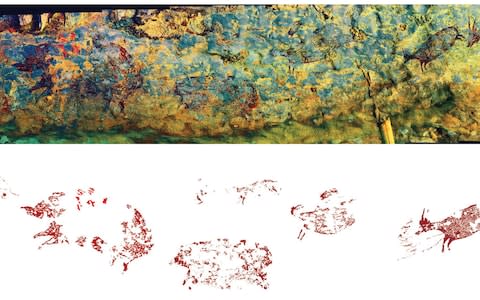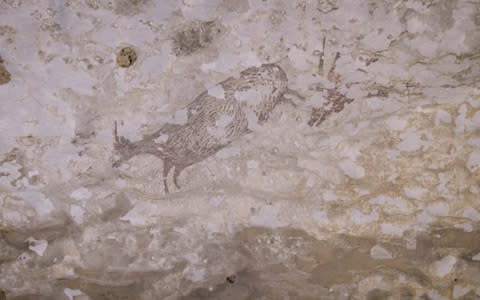Oldest cave painting in world suggests religion began in Indonesia not Europe

The roots of human religion and spirituality may have begun began on a small Indonesian island not Europe, the oldest cave paintings in the world suggest.
Archaeologists have discovered the earliest ever hunting scene dating from around 44,000 years ago which portrays a group of part-human, part-animal figures confronting large mammals with spears or ropes.
It is the oldest known rock art produced by humans ever found, and predates similar European hunting scenes found in France and Spain by more than 20,000 years.
But the new scene goes further, showing figures known as ‘therianthropes’ which share both animal and human features.
The strange figures are depicted killing two pigs and four dwarf buffaloes known as anoas, which still inhabit the island’s forests. Archaeologists believe it represents the earliest evidence of humans imagining the existence of supernatural beings, a cornerstone of religious experience.

“The images of therianthropes may represent the earliest evidence for our capacity to conceive of things that do not exist in the natural world, a basic concept that underpins modern religion,” said Associate Professor Adam Brumm from the Australian Research Centre for Human Evolution (ARCHE) at Griffith University.
“Therianthropes occur in the folklore or narrative fiction of almost every modern society and they are perceived as gods, spirits, or ancestral beings in many religions worldwide.
“Sulawesi is now home to the oldest image of this kind. Early Indonesians were creating art that may have expressed spiritual thinking about the special bond between humans and animals long before the first art was made in Europe, where it has often been assumed the roots of modern religious culture can be traced.”
Previously, archaeologists believed the origins of spirituality began in Europe where the earliest evidence of grave goods and therianthropic cave paintings emerged in the Upper Paleolithic suggesting humans had begun to believe in supernatural beings from around 30,000 years ago.
A small figurine of a lion-headed human was also found in Germany to date to 40,000 years ago and was until now thought to be the oldest depiction of a therianthrope.
But the new examples at the cave of Leang Bulu’ Sipong 4 in the Maros-Pangkep limestone cave region of South Sulawesi, suggests ritual behaviour and complex art had evolved far earlier.

By measuring the radioactive decay of uranium and other elements within mineral growths that had formed on the cave painting experts put the minimum ages of the art to between 35,100 to 43,900 years ago.
“The cave painting suggests that there was no gradual evolution of Palaeolithic art from simple to complex around 35,000 years ago – at least not in Southeast Asia,” said Professor Professor Maxime Aubert of Griffith University in South East Queensland.
“All of the major components of a highly advanced artistic culture were present in Sulawesi by 44,000 years ago, including figurative art, scenes, and therianthropes.”
The team say that when taken together with the discovery of a figurative painting of a wild bovid dating to at least 40,000 years ago in Kalimantan on the island of Borneo published last year, Indonesia is one of the most important places on Earth for the beginning of spirituality and art.

Researchers believe more paintings await discovery but are worried that the art is peeling off the cave walls at an alarming rate.
Doctoral student Adhi Agus Oktaviana of Griffith University said: “The early rock art of Sulawesi may contribute invaluable insight into the rise of human spirituality and the spread of artistic beliefs and practices that shaped our modern minds.
“It would be a tragedy if these exceptionally old artworks should disappear in our own lifetime, but it is happening. We need to understand why this globally significant rock art is deteriorating – now.”
The research was published in the journal Nature.

 Yahoo News
Yahoo News 
